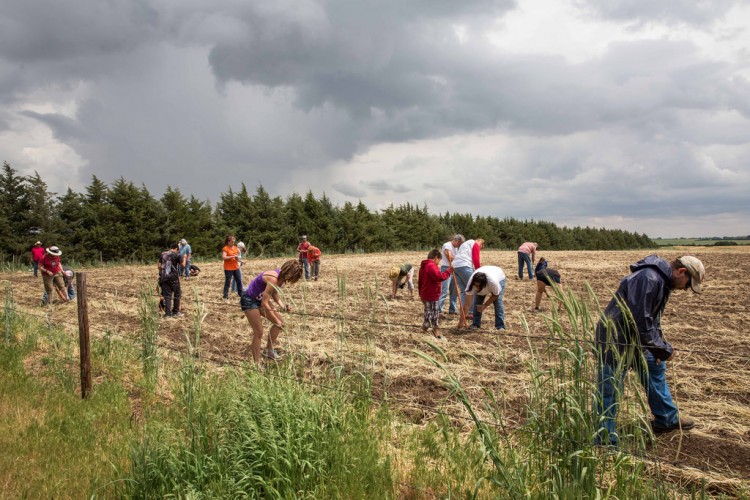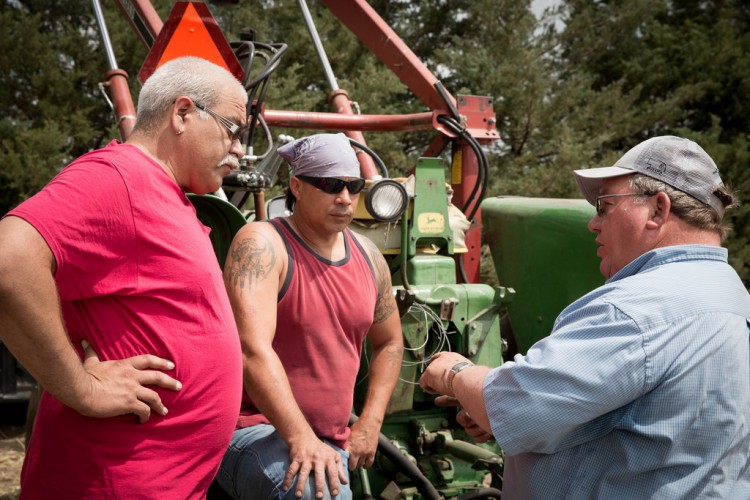

- LINK TO FLICKR: PHOTOS FOR MEDIA OF PONCA CORN PLANTING
- B-ROLL VIDEO (DOWNLOADABLE VIA DROPBOX):
FOR IMMEDIATE RELEASE: June 1, 2014
Contact: Jane Kleeb, jane@boldnebraska.org, 402-705-3622
Neligh, Nebraska—On Saturday, May 31, and Sunday, June 1, members of the Cowboy and Indian Alliance and allies came together at the farm of Art Tanderup near Neligh, Nebraska, to hand plant sacred Ponka red corn seeds. (The nineteenth century spelling of the tribe is still used in the official names of the Ponca corn varietals.) The Tanderup farm is crossed both by the historic Ponca Trail of Tears and the proposed route of the Keystone XL Pipeline.
“Our family is honored to have sacred Ponca corn seed planted here on our farm,” said Art Tanderup.
“The people of Neligh, in 1877, assisted the Ponca by burying White Buffalo Girl who died on the Ponca Trail of Tears. Over one hundred years later, that spirit of humanity continues as we join with our friends and neighbors in replenishing their sacred corn and fighting against Keystone XL.”
Saturday morning, members of the Ponca Tribe of Oklahoma performed a sacred corn planting ceremony led by Mekasi Horinek, the son of Casey Camp-Horinek, a long-time Native rights activist and environmentalist, and Amos Hinton, Agricultural Director of the Ponca Tribe of Oklahoma.
After the ceremony, the group hand planted approximately four acres of sacred Ponka red corn seed.
“We’re going to stand together with the cowboys—the ranchers and farmers—in our Nebraska homeland,” said Horinek. “Together our families will plant sacred red corn seed in our ancestral soil. As the corn grows it will stand strong for us, to help us protect and keep Mother Earth safe for our children, as we fight this battle against the Keystone XL pipeline.”
Hinton is working to find and restore the tribe’s five varietals of heirloom corn and establish a seed bank to preserve the seeds for future generations.
In 2012, he worked with Nebraska corn geneticist, Tom Hoegemeyer, the Nebraska Department of Agriculture, the Nebraska Commission on Indian Affairs, and the Intertribal Agricultural Council to plant Ponka grey corn seeds near Kearney with the assistance of the Pawnee Tribe. The successful planting yielded hundreds of pounds of heirloom seeds.
Hinton’s hope is that the Tanderup farm will be maintained as another growing site for the historic corn seeds. “In our creation story the Creator gave us three original gifts: red corn, a dog, and a bow,” explained Hinton. “I am honored to be able to provide my tribe with this historic sacred red corn, which we had not seen since my people were forced to leave Nebraska.”
Historical Background
In May 1877, the U.S. Army forcibly removed the Ponca from their land between Ponca Creek and the Niobrara River (approximately between present day Butte and Lynch, Nebraska) to Indian Territory in Oklahoma. The strenuous journey, plagued by extreme weather, claimed the lives of nine Ponca, including Chief Standing Bear’s daughter, Prairie Flower, who was buried in Milford, Nebraska, and White Buffalo Girl, the Daughter of Black Elk and Moon Hawk, who was buried by the people of Neligh, Nebraska. Today, a marble monument marks her grave in Laurel Hill Cemetery in Neligh.
Because they were removed in May, the Ponca had already planted their corn and were forced to leave with few corn seeds. When they arrived in Oklahoma at the end of the summer it was too late to plant, and the community faced starvation. As a result of these conditions, Chief Standing Bear’s eldest son Bear Shield died in Oklahoma. To fulfill a promise that he made to Bear Shield to bury him in his homeland of Nebraska, Standing Bear traveled north with his son’s body and a group of 65 followers. They were detained in Omaha.
Standing Bear is best known for his successful lawsuit against the U. S. Army for forcibly removing the Ponca from their homeland. In 1879, he was granted a writ of habeas corpus. The judged ruled that “an Indian is a person” and that the Federal Government had failed to show basis under the law for the arrest and captivity of the Ponca. Standing Bear and many of his followers returned to their home on the Niobrara River and became known as the Ponca Tribe of Nebraska. Those who remained in Oklahoma were registered as the Ponca Tribe of Indians of Oklahoma under the Dawes Allotment Act of 1892.
# # #





